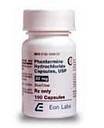|
cr dose paxil:
|
cr dose paxil Ase paroxetine tablets or placebo for 1 year demonstrated a significantly lower relapse rate for patients taking immediate-release paroxetine tablets (15%) compared to those on placebo (39%). Effectiveness was similar for male and female patients. Panic Disorder: The effectiveness of PAXIL CR in the treatment of panic disorder was evaluated in three 10-week cr dose paxil, multicenter cr dose paxil, flexible-dose studies (Studies 1 cr dose paxil, 2 cr dose paxil, and 3) comparing paroxetine controlled-release (12.5 to 75 mg daily) to placebo in adult outpatients who had panic disorder (DSM-IV) cr dose paxil, with or without agoraphobia. These trials were assessed on the basis of their outcomes on 3 variables: (1) the proportion cr dose paxil.
cr dose paxil S of patients free of full panic attacks at endpoint; (2) change from baseline to endpoint in the median number of full panic attacks; and (3) change from baseline to endpoint in the median Clinical Global Impression Severity score. For Studies 1 and 2 cr dose paxil, PAXIL CR was consistently superior to placebo on 2 of these 3 variables. Study 3 failed to consistently demonstrate a significant difference between PAXIL CR and placebo on any of these variables. For all 3 studies cr dose paxil, the mean dose of PAXIL CR for completers at endpoint was approximately 50 mg day. Subgroup analyses did not indicate that there were any differences in treatment outcomes as a function of age or gender. Long-term maintenance effects of the immediate-release formulation of paroxetine in panic disorder were demonstrated in an extension study. Patients who were responders during a 10-week double-blind phase with immediate-release paroxetine and during a 3-month double-blind extension phase were randomized to either immediate-release paroxetine or placebo in a 3-month double-blind relapse prevention phase. Patients randomized to paroxetine were significantly less likely to relapse than comparably treated patients who were randomized to placebo. Social Anxiety Disorder: The efficacy of PAXIL CR as a treatment for social anxiety disorder has been establishe.
cr dose paxil Nder. Long-term maintenance effects of the immediate-release formulation of paroxetine in panic disorder were demonstrated in an extension study. Patients who were responders during a 10-week double-blind phase with immediate-release paroxetine and during a 3-month double-blind extension phase were randomized to either immediate-release paroxetine or placebo in a 3-month double-blind relapse prevention phase. Patients randomized to paroxetine were significantly less likely to relapse than comparably treated patients who were randomized to placebo. Social Anxiety Disorder: The efficacy of PAXIL CR as a treatment for social anxiety disorder has been established.
cr dose paxil 
cr dose paxil | | | | | |
cr dose paxil
|
|
S an anti-depressant drug that affects the chemicals that nerves in the brain use to communicate with one another. These chemical messengers, called neurotransmitters, are released by one nerve and taken up by other nerves. Neurotransmitters that are released but not taken up by other nerves are taken up by the nerves that release them ("reuptake"). Many experts believe that it is an imbalance among the amounts of the different neurotransmitters that are released that causes depression. Paroxetine works by inhibiting the reuptake of serotonin by the nerves that release it, an action which allows more serotonin to be available to be taken up by other nerves. Paroxetine is in a class of drugs called selective serotonin reuptake inhibitors (SSRIs), a class that also contains fluoxetine (Prozac) and sertraline (Zoloft). PRESCRIPTION: Yes GENERIC AVAILABLE: Yes PREPARATIONS: Tablets (oval): 10 mg (yellow), 20 mg (pink), 30 mg (blue), and 40 mg (green). Paxil CR, a controlled release form of paroxetine, is available in tablets of 12.5, 25, and 37.5 mg. STORAGE: Tablets should be kept at room temperature, 15- 30°C (59-86°F). PRESCRIBED FOR: Paroxetine is indicated for the management of depression, obsessive-compulsive disorders, panic disorders, and premenstrual dysphoric disorder. DOSING: Paroxetine is given as a single daily dose, usually in the morning. As with all anti-depressants, the full effect may not occur until after a few weeks of therapy. Doses for obsessive- compulsive disorders and panic disorders are often higher than those for depression. Doses often are adjusted t
| Information paxil | Paxil lawsuits | Effects its paxil side | Celexa vs paxil | Information about paxil | Gain paxil weight | Paxil and pregnancy | [ Phentermine ]
|
|

